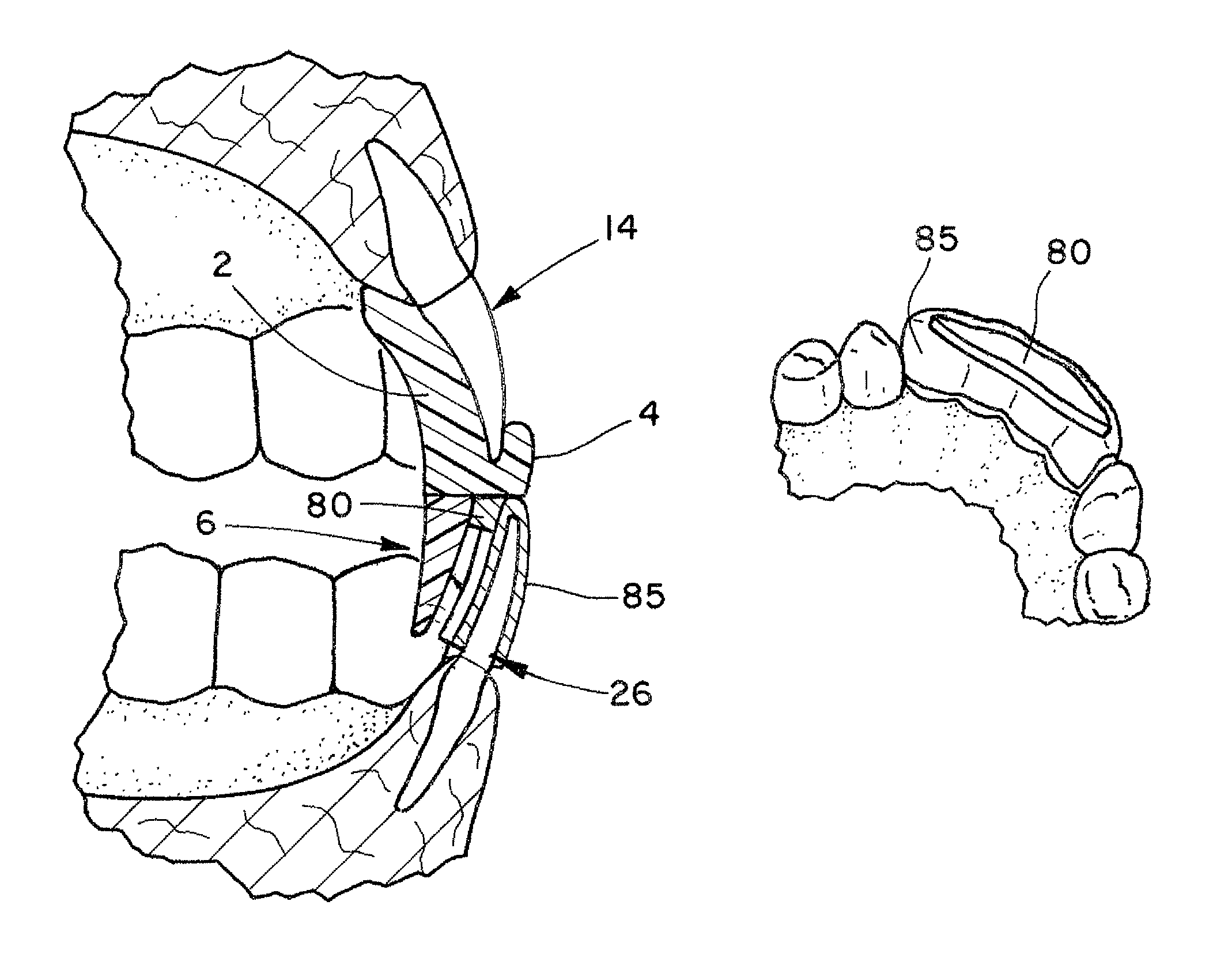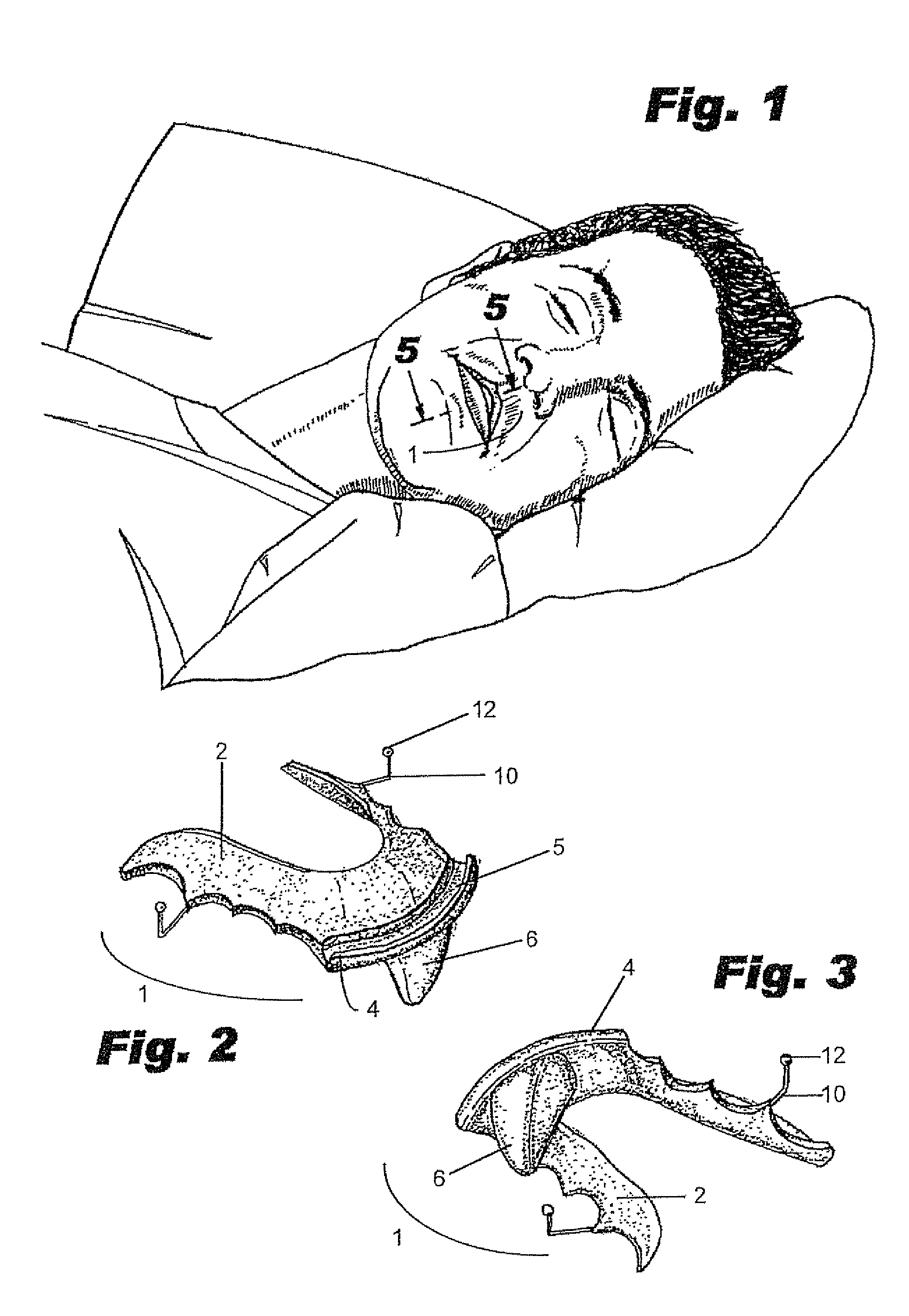The most widespread
sleep disorder is snoring which is a common affliction that affects tens of millions of people worldwide, and can potentially have very serious health and social consequences.
Lack of sleep subsequently leads to
daytime fatigue, a compromised
immune system, poor mental and emotional health,
irritability and lack of productivity, which can lead to further repercussions.
Snoring is thus problematic for many people.
Arousals may occur hundreds of times each night, and may not fully awaken the individual, who remains otherwise unaware of the loud snoring,
choking and gasping for air typically associated with OSA.
Many OSA sufferers do not receive a sufficient amount of sleep due to repeated apneatic events and arousals which act to prevent REM and deep stage sleep, which can lead to chronic
daytime exhaustion and long-term cardiovascular stress.
When the
breathing airway is blocked,
exhaled air is forced through the airway with increased velocity thereby causing vibration of the tongue, tissue, or other obstruction, thereby creating
noise.
Invasive surgery however is costly and not without risk, which effectively eliminates this modality as a truly viable solution to snoring and OSA for the general
population.
Known in the art are devices (heretofore cumbersome or ineffective) which are designed to
restrict the velocity of the ingress and egress of air with the goal of reducing or eliminating snoring.
Yet, reduction of
airflow can cause a
cascade of other symptomology and situations, including potential OSA.
Yet, such devices do not address the source of the problem or intervene to increase the airway (as does the instant invention), and thus the
cascade effect is still a present risk if such devices are employed.
Various devices have sought to alleviate snoring by aiming to keep the pharyngeal airway open to prevent the collapse of the tongue and soft tissues in the back of the
throat, yet are bulky and uncomfortable, often resulting in reduced
patient compliance.
Positioning of the body does not eliminate the cause of snoring.
One can only image how truly uncomfortable such devices must be if used at all, and thus the likelihood of
patient compliance is small to nil.
Both OSA and
GERD involve a reduction in air pressure in the trachea and
esophagus caused by blockage during sleeping, thereby resulting in an increase in the draw of pressure through the
esophagus as the diaphragm distends.
While the body tends to increase
breathing by such distention, the blockage results in the pulling of fluid upwardly in the
esophagus and hence results in GERD for the snorer or OSA patient.
The former involves a face
mask and a pump to provide pressure directly to the trachea of the patient which is cumbersome and unaesthetic.
The latter obviously includes a plethora of side effects associated with the
pharmacology employed, while not directly addressing the physical / mechanical source of the problem.
A number of different appliances for the treatment of snoring or OSA which move the mandible forward relative to the maxilla have been suggested, yet such devices typically fit over both the arches of teeth and are thus large and cumbersome.
Thus, to achieve anterior movement of the mandible, these devices essentially move one jaw against the other in a cumbersome manner which no doubt has an effect on
patient compliance.
Studies have shown however that
partial coverage of the teeth during sleep does not result in undesired eruption of uncovered teeth, therefore rendering previous concerns unwarranted.
These devices are therefore unnecessarily bulky and difficult to fit over the user's teeth.
Bulky devices also occupy a large portion of the oropharyngeal volume, thus making
breathing, and the passage of air around the bulky device difficult—the very antithesis of the goal herein sought: to increase the dimensional size of the airway.
Many devices claimed for treatment of snoring or OSA which move the mandible forward relative to the maxilla fit over both the arches of teeth and also move one jaw substantially against the other, thereby posing other potentially damaging effects.
Mandibular advancement devices that fit over both the maxillary and
mandibular teeth are typically held nearly stationary, thereby restricting movement, causing discomfort, and potential permanent repositioning of the jaw.
Since these types of devices
restrict the user's natural lateral movements as well as anterior and posterior movements, continued use can potentially aggravate the tempromandibular joint (TMJ) and the related facial musculature, which would worsen over time, with continued use.
The device disclosed in Hakimi has a posterior position which fits against the dorsal surface of the user's
soft palate to secure the device, which may also cause gagging or other discomfort, thus reducing or eliminating
efficacy.
Although prior devices may have effect in treating snoring and OSA by moving the mandible forward relative to the maxilla to open the airway, such devices have unwanted side effects or are ineffective due to, inter alia, their bulk.
Thus, such devices would not function properly with users who have difficulty breathing through their noses.
Furthermore, many of these devices must be removed or unhinged or otherwise disengaged to allow the user freedom to speak, swallow, or drink water, thus creating serious inconvenience to the user (and poor aesthetics).
GERD can cause serious complications including
inflammation of the esophagus from
stomach acid that causes bleeding or ulcers.
The
liquid content of the
stomach typically contains acid,
pepsin, and bile, which are harmful to the delicate lining of the esophagus when regurgitated.
Damage to the esophageal lining can result in scarring and narrowing of the esophagus, and can be linked to the development of
esophageal cancer.
When in a
supine position however, most refluxed liquid is forced upwardly, into the esophagus, typically causing damage thereto.
Yet these devices have drawbacks, as herein stated, and thus are not of choice especially if non-invasive, easily placeable and removable, and not uncomfortable alternatives, like that of the instant invention, are available.
Although there exists a broad range of dentally-retained intraoral appliances worn at night for the treatment of snoring and obstructive
sleep apnea, no such appliances heretofore satisfied such criteria and, also, were directed at treatment of GERD.
The risk of bruxism increases with age, stress, and use of
caffeine,
nicotine and other drugs.
When bruxing is more frequent however it can lead to jaw disorders,
headaches, earaches, damaged teeth, chronic facial pains, and other problems.
However, the device in Pivovarov encompasses both the mandibular and maxillary teeth, and is bulky and uncomfortable.
Yet, such devices heretofore shown in the art that are aimed to prevent bruxism or damage caused by bruxing fail to address or effectively aid in the treatment of snoring, OSA and GERD.
As shown above, prior devices have struggled to optimize the size and design parameters to facilitate the dual goals of comfort and effectiveness, but have woefully failed to achieve this goal.
Thus, compliance is a predominant issue.
 Login to View More
Login to View More  Login to View More
Login to View More 


